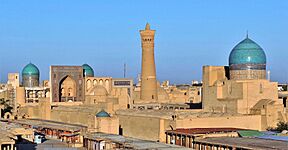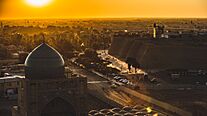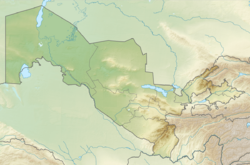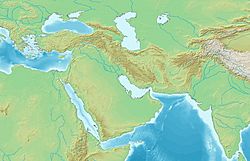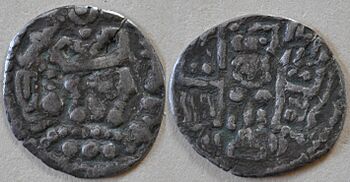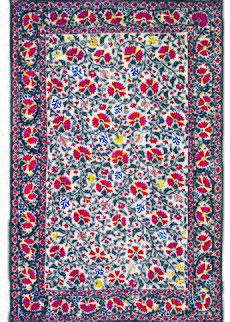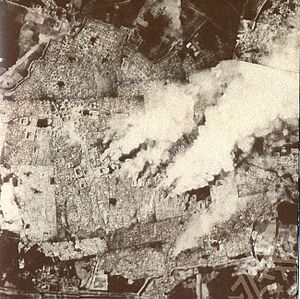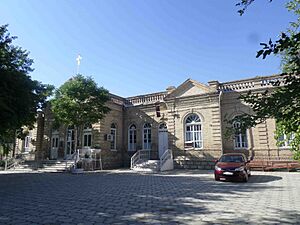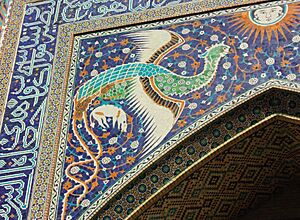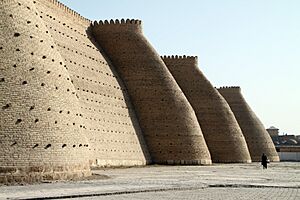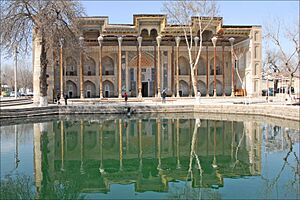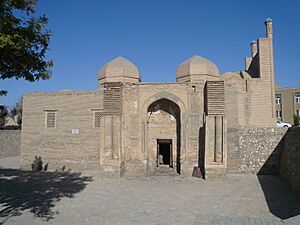Bukhara facts for kids
Quick facts for kids
Bukhara
Бухара
|
|
|---|---|
|
City
|
|
|
From top, left to right: Po-i-Kalyan Mosque with the Kalyan Minaret in the middle, Ismail Samani Mausoleum, Ark of Bukhara, Chor Minor, and Panoramic sunset view around Po-i-Kalyan Mosque and Ark of Bukhara
|
|
| Country | |
| Region | Bukhara |
| Founded | 6th century BC |
| First mention | 500 AD |
| Government | |
| • Type | City Administration |
| Area | |
| • City | 143.0 km2 (55.213 sq mi) |
| • Urban | 73.0 km2 (28.2 sq mi) |
| Elevation | 225 m (738 ft) |
| Population
(2020)
|
|
| • City | 280,187 |
| • Density | 1,959.3/km2 (5,074.66/sq mi) |
| Demonym(s) | Bukharan Bukharian |
| Time zone | GMT +5 |
| Postcode |
2001ХХ
|
| Area code(s) | (+998) 65 |
| Vehicle registration | 20 (previous to 2008) 80-84 (2008 and newer) |
| HDI (2018) | 0.734 · 5th high |
| Official name: Historic Centre of Bukhara | |
| Type: | Cultural |
| Criteria: | ii, iv, vi |
| Designated: | 1993 |
| Reference #: | 602 |
| Region: | Asia |
Bukhara (/bʊˈxɑːrə/ buu-KHAR-ə) is a famous city in Uzbekistan. It is the seventh-largest city in the country. About 280,000 people lived there in 2020. Bukhara is also the capital of the Bukhara Region.
People have lived in this area for at least 5,000 years. The city itself has been around for half that time. Bukhara was an important stop on the ancient Silk Road. It was a major center for trade, learning, culture, and religion. Many important scholars were born here, like Imam Bukhari. The city is often called "Noble Bukhara" (Bukhārā-ye sharīf).
Bukhara has about 140 amazing old buildings. Its historic center, with many mosques and madrasas (schools), is a World Heritage Site recognized by UNESCO.
Contents
What Does Bukhara Mean?
The exact old name of Bukhara is not fully known. In ancient times, the whole oasis was called Bukhara. The name likely moved to the city itself around the 10th century.
Some experts think the name comes from the Sanskrit word vihāra. This word means a Buddhist monastery. It is similar to words used by Uyghur and Chinese Buddhists for their places of worship. While few Buddhist items remain today, old travelers and historians wrote that Uzbekistan was once home to many Buddhists and Zoroastrians.
Other sources, like Encyclopædia Iranica, suggest the name Bukhara might come from the Sogdian word βuxārak. This means 'Place of Good Fortune'. It was another name for Buddhist monasteries.
In ancient China, during the Tang dynasty, Bukhara was known as Bǔhē (捕喝). Today, the Chinese name is Bùhālā (布哈拉).
Between the 19th and 20th centuries, English books often called the city Bokhara. This was especially true during the time of the Emirate of Bukhara.
Muhammad ibn Jafar Narshakhi, a historian, wrote in his History of Bukhara (around 943 AD):
Bukhara has many names. One of its names was Numijkat. It has also been called "Bumiskat". It has 2 names in Arabic. One is "Madinat al Sufriya" meaning—"the copper city" and another is "Madinat Al Tujjar" meaning—"The city of Merchants". But, the name Bukhara is the original name and more known than all the other names. In Khorasan, there is no other city with so many names.
Since the Middle Ages, the city has been known as Bukhārā / بخارا in Arabic and Persian. The modern Uzbek spelling is Buxoro.
Bukhara's Long History
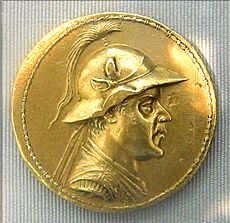
The history of Bukhara goes back thousands of years. Along with Samarkand, Bukhara was a very important center for Persian culture in medieval Asia. This lasted until the Timurid dynasty fell.
By 850 AD, Bukhara became the capital of the Samanid Empire. It was also the birthplace of Imam Bukhari, a very important Islamic scholar. The Samanids helped Persian culture grow far from Baghdad, which was the center of the Islamic world. New Persian language and poetry became very popular in Bukhara. Rudaki, known as the father of Persian poetry, was born and grew up in Bukhara. He wrote his most famous poem about the city's beauty.
Bukhara continued to be a key city for many empires. These included the Samanids, Karakhanids, Khwarazmids, and Timurids.
In the early 11th century, Bukhara became part of the Turkic state of the Karakhanids. Their rulers built many famous buildings in Bukhara. These include the Kalyan minaret and the Magoki Attori mosque.
Bukhara is west of Samarkand. It was a major place of learning throughout the Persian and Islamic world. It is the hometown of the great Sheik Naqshbandi. He was a key figure in the development of Sufism, a mystical approach to religion and Islam.
Today, Bukhara is the capital of the Bukhara Region in Uzbekistan. Because it was on the Silk Road, the city has always been a center for trade, learning, culture, and religion. During the golden age of the Samanids, Bukhara became a major intellectual center of the Islamic world. It was known for its many libraries. The historic center of Bukhara, with its many mosques and madrassas, is a World Heritage Site listed by UNESCO.
Genghis Khan attacked Bukhara for 15 days in 1220. Bukhara was an important trading center. It was home to a group of medieval Indian merchants from Multan (now in Pakistan). These merchants even owned land in the city.
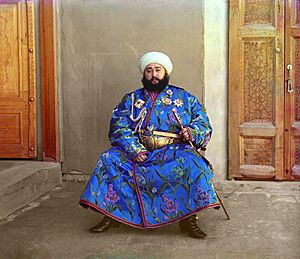
Bukhara was the last capital of the Emirate of Bukhara. It was attacked by the Red Army during the Russian Civil War. In 1920, Red Army troops attacked the city. On August 31, 1920, the Emir Alim Khan fled. On September 2, 1920, after four days of fighting, the emir's castle (the Ark) was destroyed. A new government was set up on September 14, 1920.
The Bukharan People's Soviet Republic existed from 1920 to 1924. Then, the city became part of the Uzbek Soviet Socialist Republic. Later in the 20th century, wars in Afghanistan and Tajikistan brought refugees who spoke Dari and Tajik into Bukhara and Samarkand.
Famous Landmarks
Bukhara is full of amazing old buildings and places.
Architectural Wonders
- Po-i-Kalyan Complex. This means 'Grand Foundation'. It is a group of buildings around the huge Kalân minaret.
- Kalyan minaret. This is also called Minâra-i Kalân, meaning 'Grand Minaret'. It is sometimes known as the Tower of Death. Legend says criminals were thrown from its top for centuries. The minaret is the most famous part of the city's historic center. It is very tall and can be seen from far away. The minaret is 45.6 m (150 ft) high. It has a spiral staircase inside that leads to the top.
- Kalân Mosque (Masjid-i Kalân). This mosque was finished around 1514. It is as big as the Bibi-Khanym Mosque in Samarkand. The mosque can hold 12,000 people. It has many domes supported by 288 large pillars.
- Mir-i Arab Madrassah (1535–1536). This school was built by Sheikh Abdullah Yamani, also known as Mir-i-Arab. He was a spiritual guide to Ubaidullah Khan, a ruler. It is said that Ubaidullah Khan used money from freeing Persian captives to build this madrasah. He was very religious and was buried in the madrasah next to his teacher, Mir-i-Arab.
- Lab-i Hauz Complex (meaning by the pond). This area has one of the few remaining hauz, or ponds, in Bukhara. In the past, many such ponds provided water for the city. But they also spread diseases, so most were filled in during the 1920s and 1930s. The Lab-i Hauz survived because it was the center of a beautiful group of buildings from the 16th and 17th centuries. The complex includes the Kukeldash Madrasah (16th century), a lodging-house for Sufis, and another madrasah (both 17th century).
- You can also see a metal statue of Nasruddin Hodja here. He is a clever and kind character from many children's folk stories in Central Asia. He sits on his mule with one hand on his heart.
- Bahoutdin Architectural Complex is a special burial ground. It honors Shaykh Baha-ud-Din, who started the Naqshbandi religious order. The complex includes his gravestone, two mosques, and a khanqah (a place for Sufi gatherings). This site is being considered for the UNESCO World Heritage Site list.
Strong Fortresses
- Bukhara Fortress, the Ark
This is a large fortress that was once a royal city. It was home to the rulers of Bukhara for many centuries.
Ancient Burial Sites
- Boboyi Poradoz Mausoleum
This mausoleum (burial place) was built in the 19th century. It is an important architectural monument in Bukhara.
- Chashma-Ayub Mausoleum
Chashma-Ayub means Job's spring. It is near the Samani mausoleum. A legend says that the prophet Job visited this place and made a spring appear by hitting the ground with his staff. The water from this well is said to be very pure and have healing powers. The building you see today was built during the time of Timur. It has a unique conical dome.
- Ismail Samani mausoleum
This mausoleum (built between the 9th and 10th centuries) is one of the most respected buildings in Central Asia. It was built for Ismail Samani. He was the founder of the Samanid dynasty, which was the last native Persian ruling family in the region.
The building is special because it mixes Zoroastrian and Islamic designs. Its outside is covered in detailed brickwork with circular patterns. These patterns look like the sun, which was a common symbol in Zoroastrian art. The building's shape is like a cube, similar to the Ka'aba in Makkah. The domed roof is common in mosque architecture. This mix of styles shows that in the 9th and 10th centuries, many Zoroastrians were converting to Islam.
This shrine is one of the oldest monuments in Bukhara. When Genghis Khan invaded, the shrine was already buried in mud from floods. So, it was saved from being destroyed by the Mongol army.
Beautiful Mosques
- Bolo Haouz Mosque
Built in 1712, this mosque is across from the Ark fortress. It is part of the UNESCO World Heritage Site. It was used as a main Friday mosque when Bukhara was under Russian rule in the 1920s.
- Char Minar
Char Minar (also called Chor Minor) is a unique building hidden away from the main complex. It was built in the 19th century by Khalif Niyaz-kul, a rich man from Bukhara. The building has four towers. People sometimes think it's a gate, but it's actually a complex with a mosque and living spaces.
The main part is a mosque. Even though it looks unusual from the outside, the inside is typical for a Central Asian mosque. The dome gives the room great sound, making it a special place for Sufi ceremonies. These ceremonies often include singing and music.
Each of the four towers has different decorations. Some people believe the decorations show elements from four religions known in Central Asia. You can find symbols that look like a cross, a Christian fish, a Buddhist praying-wheel, and also Zoroastrian and Islamic designs.
- Magok-i-Attari Mosque
The Magok-i-Attari mosque was built in the 9th century. It might have been built on the remains of an even older Zoroastrian temple. The mosque was destroyed and rebuilt several times. The oldest part remaining today is the south side, which is from the 12th century. This makes it one of the oldest buildings in Bukhara. It was also one of the few buildings that survived Genghis Khan's attack. It is now a carpet museum.
- Mosque of Mir Sayyid Ali Hamadani
There is a mosque in Bukhara said to belong to Mir Sayyid Ali Hamadani. He is a very important saint for Kashmiri Muslims.
- Shirbudun Palace
The Shirbudun Palace was a political building for the emirs (rulers) of Bukhara. Its construction began around 1870.
- Bukhara Prison
The Bukhara Prison was the prison of the Amir of Bukhara. It was built in the late 18th century. It is located near the old city and the Ark fortress.
- Jandi Turki Mausoleum
The Jandi Turki Mausoleum is in the old part of Bukhara. It is linked to Abu Nasr Ahmad ibn Fazl ibn Muso al-Muzakkir al-Jandi.
- Khanqah of Nodir Devonbegi
The Nodir Devonbegi is a historical monument in Bukhara. It was built around 1620–1621 by Nodir Devonbegi. He was a vizier (a high official) and brother of the ruler, Imamquli Khan.
Bukhara's Location and Weather
Bukhara is about 140 miles (230 km) west of Samarkand in south-central Uzbekistan. It is located on the Zeravshan River, about 751 feet (229 meters) above sea level.
Climate and Water
Bukhara has a typical Central Asian cool arid climate. This means it has hot summers and cold winters. The average high temperature in January is 6.6 °C or 43.9 °F. In July, it rises to about 37.2 °C or 99.0 °F. The city gets about 135 millimetres or 5.31 inches of rain each year.
Water has always been very important in this hot, dry region. People developed irrigation farming long ago. Cities were built near rivers, and water channels were created to serve the whole city. Open reservoirs, called hauzes, were built. Special covered water reservoirs, or sardobas, were built along trade routes to provide water for travelers and their animals.
| Climate data for Bukhara (1991–2020, extremes since 2000) | |||||||||||||
|---|---|---|---|---|---|---|---|---|---|---|---|---|---|
| Month | Jan | Feb | Mar | Apr | May | Jun | Jul | Aug | Sep | Oct | Nov | Dec | Year |
| Record high °C (°F) | 22.6 (72.7) |
29.6 (85.3) |
35.0 (95.0) |
38.2 (100.8) |
43.0 (109.4) |
46.2 (115.2) |
45.8 (114.4) |
44.6 (112.3) |
39.1 (102.4) |
37.8 (100.0) |
31.7 (89.1) |
26.1 (79.0) |
46.2 (115.2) |
| Mean daily maximum °C (°F) | 7.0 (44.6) |
10.0 (50.0) |
17.1 (62.8) |
24.4 (75.9) |
30.7 (87.3) |
36.0 (96.8) |
37.3 (99.1) |
35.6 (96.1) |
30.0 (86.0) |
22.9 (73.2) |
14.5 (58.1) |
8.2 (46.8) |
22.8 (73.0) |
| Daily mean °C (°F) | 1.8 (35.2) |
4.1 (39.4) |
10.3 (50.5) |
17.2 (63.0) |
23.4 (74.1) |
28.4 (83.1) |
29.8 (85.6) |
27.6 (81.7) |
21.7 (71.1) |
14.6 (58.3) |
7.6 (45.7) |
2.8 (37.0) |
15.8 (60.4) |
| Mean daily minimum °C (°F) | −2.2 (28.0) |
−0.4 (31.3) |
4.7 (40.5) |
10.5 (50.9) |
15.6 (60.1) |
19.9 (67.8) |
21.6 (70.9) |
19.4 (66.9) |
13.6 (56.5) |
7.4 (45.3) |
2.2 (36.0) |
−1.2 (29.8) |
9.3 (48.7) |
| Record low °C (°F) | −23.5 (−10.3) |
−18.1 (−0.6) |
−8.2 (17.2) |
0.0 (32.0) |
1.3 (34.3) |
9.8 (49.6) |
14.7 (58.5) |
10.3 (50.5) |
1.6 (34.9) |
−3.3 (26.1) |
−14.0 (6.8) |
−16.5 (2.3) |
−23.5 (−10.3) |
| Average precipitation mm (inches) | 16.5 (0.65) |
24.1 (0.95) |
25.1 (0.99) |
22.3 (0.88) |
11.1 (0.44) |
1.8 (0.07) |
0.4 (0.02) |
0.3 (0.01) |
0.8 (0.03) |
2.7 (0.11) |
14.5 (0.57) |
12.8 (0.50) |
132.4 (5.21) |
| Average precipitation days (≥ 1.0 mm) | 10 | 10 | 10 | 8 | 7 | 3 | 1 | 1 | 1 | 4 | 8 | 9 | 72 |
| Average snowy days | 3.38 | 2.33 | 0.63 | 0.04 | 0 | 0 | 0 | 0 | 0 | 0.04 | 0.71 | 2.54 | 9.67 |
| Average relative humidity (%) | 80 | 75 | 72 | 59 | 46 | 38 | 40 | 44 | 48 | 56 | 64 | 79 | 58 |
| Source 1: NOAA | |||||||||||||
| Source 2: Deutscher Wetterdienst (humidity), Meteomanz(snowy days 2000-2023 and records) | |||||||||||||
Getting Around Bukhara
Bukhara International Airport has regular flights to cities in Uzbekistan and Russia. The border with Turkmenistan is about 80 km away. The city is also connected by train to the rest of Uzbekistan. It is a main point for roads leading to all major cities in Uzbekistan and beyond. This includes Mazar-i-Sharif in Afghanistan. The city of Samarkand is 215 km east of Bukhara.
Inside the City
Bukhara is a very important transport hub in Uzbekistan, second only to Tashkent. Inside the city, you can travel by bus. There are over 45 bus lines. Most buses are ISUZU, but some are from China. Bukhara has the most buses and bus routes after Tashkent.
People of Bukhara
In 2019, Bukhara had a population of 279,200 people. Bukhara is one of the two main centers for Uzbekistan's Tajik minority. Bukhara was also home to the Bukharan Jews. Their ancestors settled in the city during Roman times. Most Bukharian Jews left Bukhara between 1925 and 2000.
Ali-Akbar Dehkhoda, a scholar, said that the name Bukhara means "full of knowledge." This refers to how Bukhara was a center for science and learning long ago.
In the Italian epic poem Orlando innamorato, Bukhara is called Albracca. It is described as a major city in Cathay (China). In the story, Angelica and her knight friends defend the city when it is attacked. This attack is similar to the real historic siege by Genghis Khan in 1220.
Ethnic Groups
Official numbers say that 82% of the city's population are Uzbeks. There are also 6% Russians, 4% Tajiks, 3% Tatars, 1% Koreans, 1% Turkmens, 1% Ukrainians, and 2% other groups. However, many experts believe that the city's population is mostly Tajik-speaking Tajiks. Many people might identify as "Uzbek" even if Tajik is their first language.
Religions
The main religion in Bukhara is Islam. Most Muslims are Sunni Muslims, making up 88% of the population. Eastern Orthodox Christians make up 9%, and other religions make up 3%.
Famous People from Bukhara
Many important people lived in Bukhara throughout history. Here are some of them:
- An Lushan (c. 703–757)
- Muhammad Ibn Ismail Ibn Ibrahim Ibn al-Mughirah Ibn Bardizbah al-Bukhari (810–870) – an Islamic scholar
- Avicenna (Abu Ali ibn Sina) (980–1037) – a Persian doctor and philosopher
- Qumri (lived in the mid-10th Century) – a doctor and scholar, said to be Avicenna's teacher
- Bal'ami: Abolfazl Muhammad and his son Abu-Ali Mohammad – two famous Persian viziers (high officials)
- Abubakr Narshakhi (10th century) – a historian who wrote History of Bukhara
- Sadiduddin Muhammad Aufi (1171–1242) – a historian and author
- Syed Jalaluddin Surkh-Posh Bukhari (1199–1291 CE)
- Sayyid Ajjal Shams al-Din Omar (1211–1279)
- Baha-ud-Din Naqshband Bukhari (1318–1389)
- Amir Kulal (died in 1370)
- Sadriddin Ayni (1878–1954)
- Abdurauf Fitrat (1886–1938)
- Fayzulla Xoʻjayev (1896–1938)
- Ibraghim Muminov (1908–1974)
- Sorojon Yusufova (1910–1966)
- Muhammadjon Shakuri (1925–2012)
- Yitzhak Apeloig (born 1944) – an Israeli chemistry professor
- Oksana Chusovitina (born 1975) – an 8-time Olympic gymnast
- Yulduz Turdiyeva (born 1985) – an Uzbek singer
Bukhara's Sister Cities
Bukhara has special connections with other cities around the world. These are called sister cities:
Images for kids
-
An old coin from the Greco-Bactrian Kingdom found in Bukhara.
-
Amir Alim Khan, the last ruler of Bukhara, around 1911.
See also
 In Spanish: Bujará para niños
In Spanish: Bujará para niños


